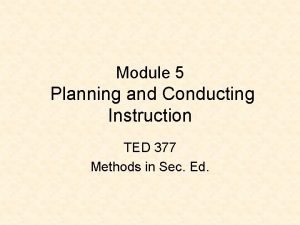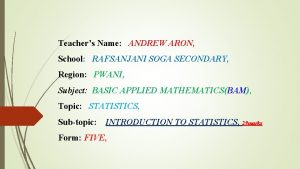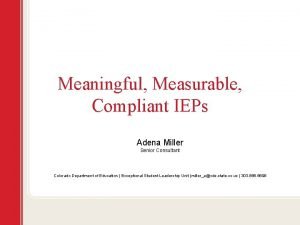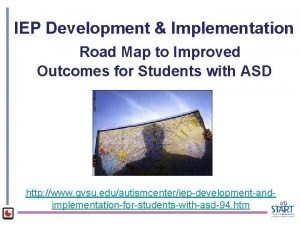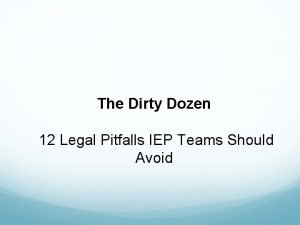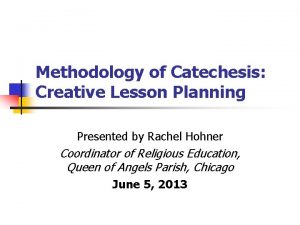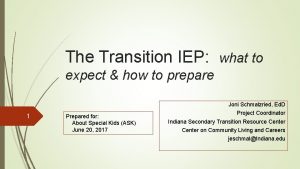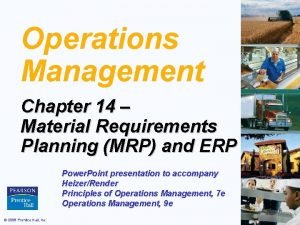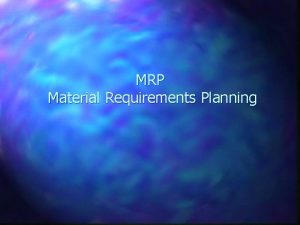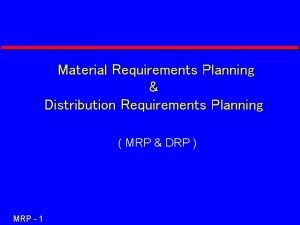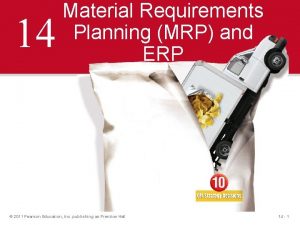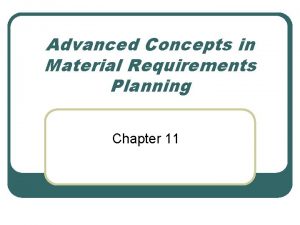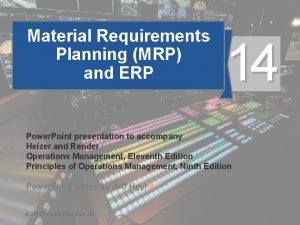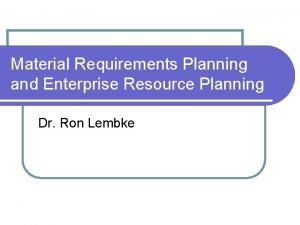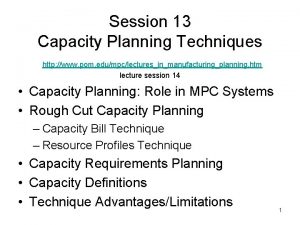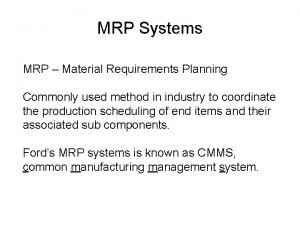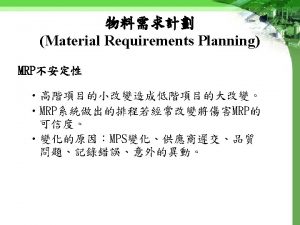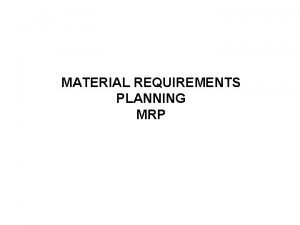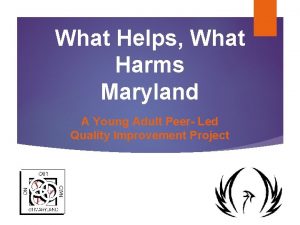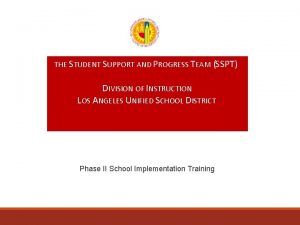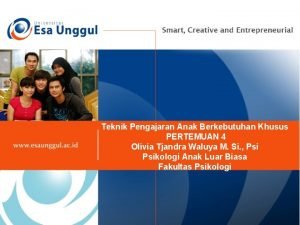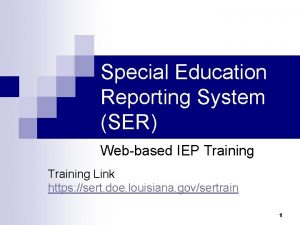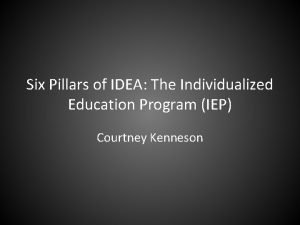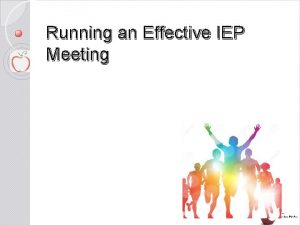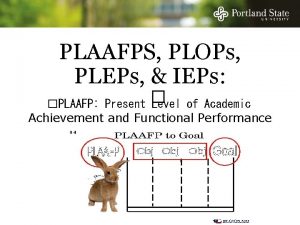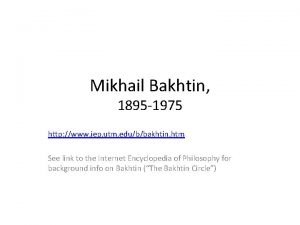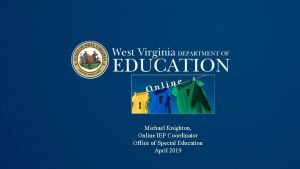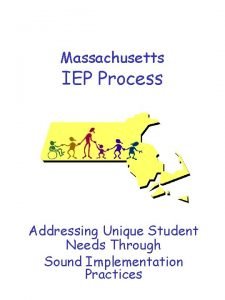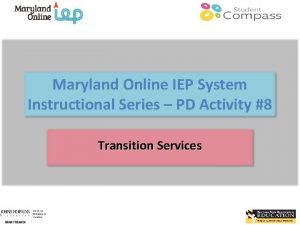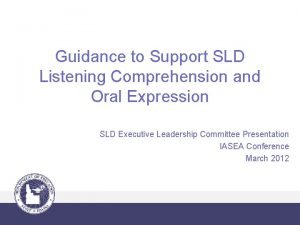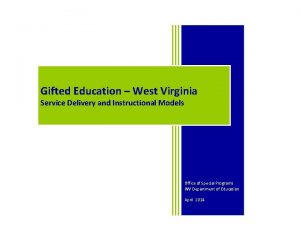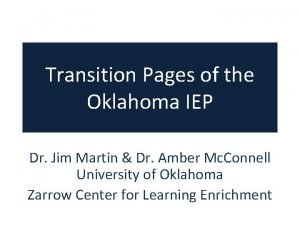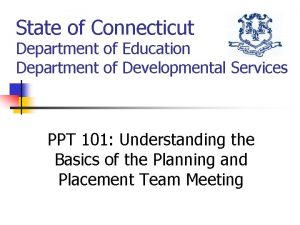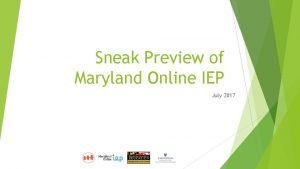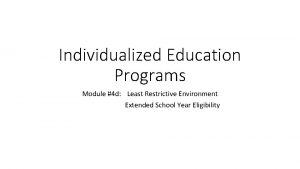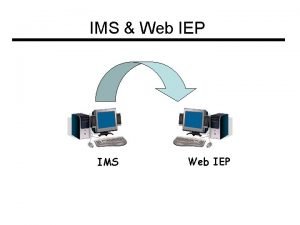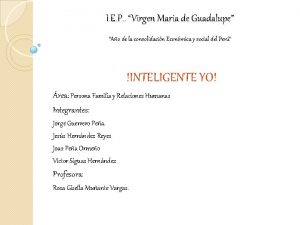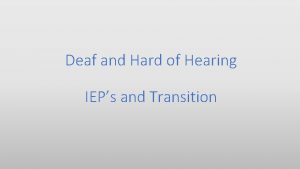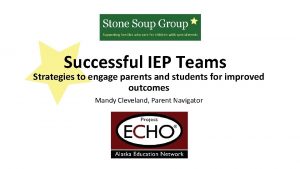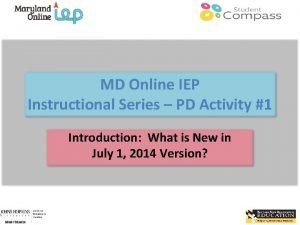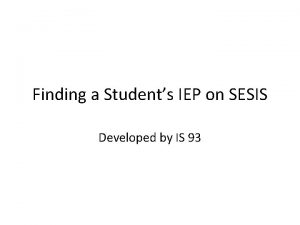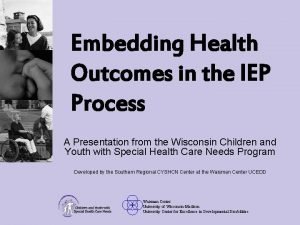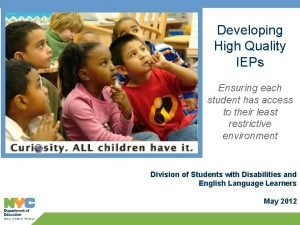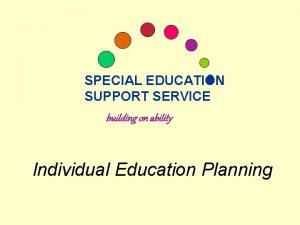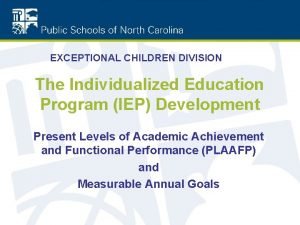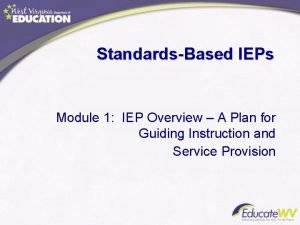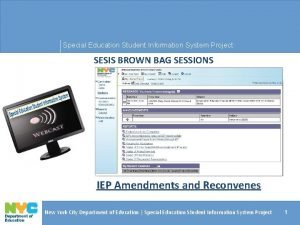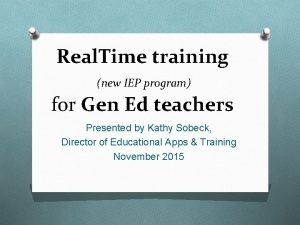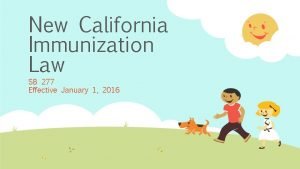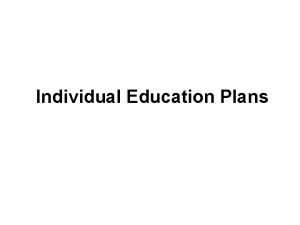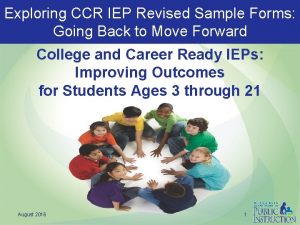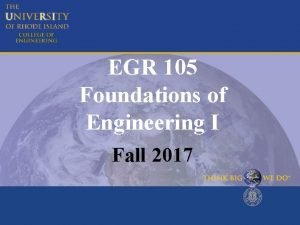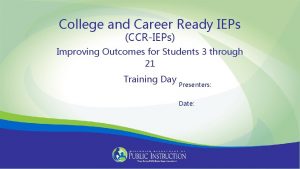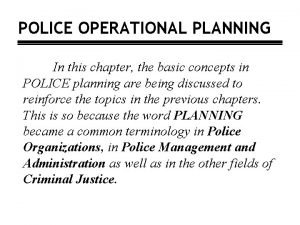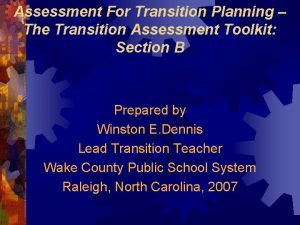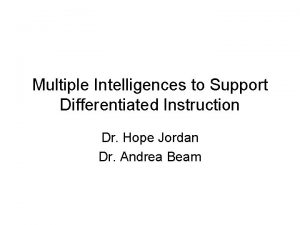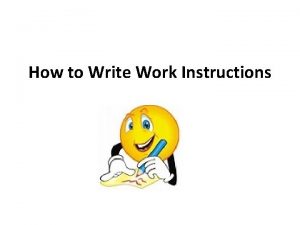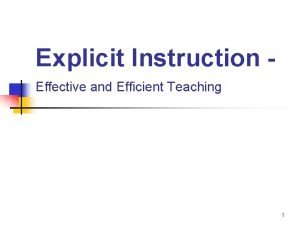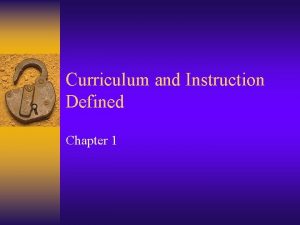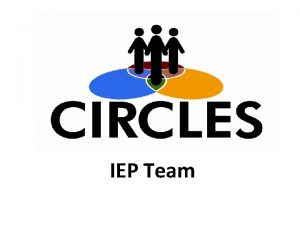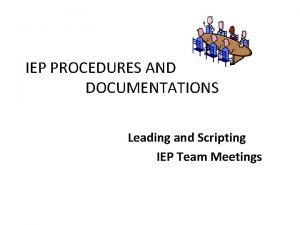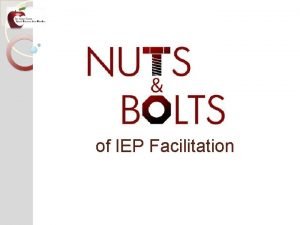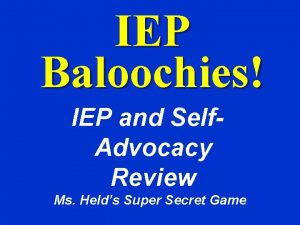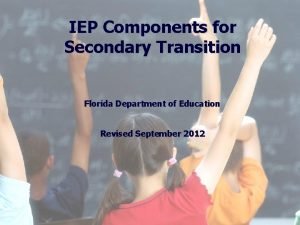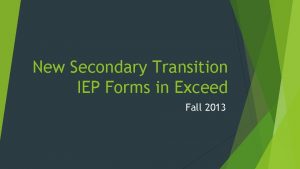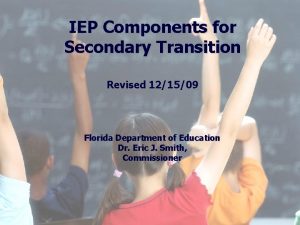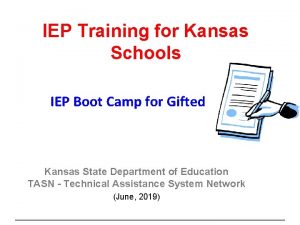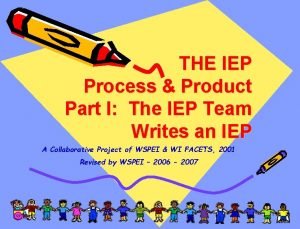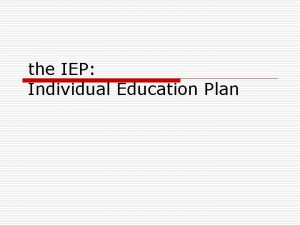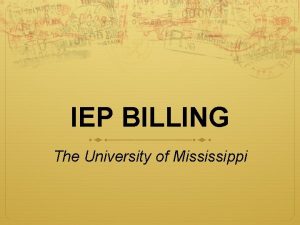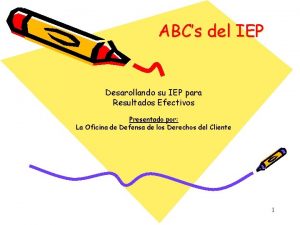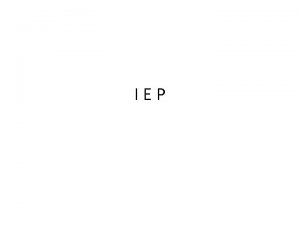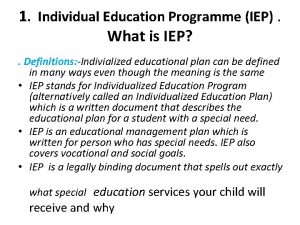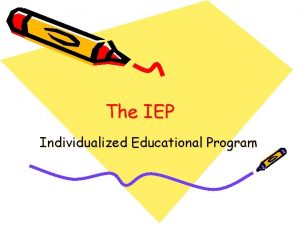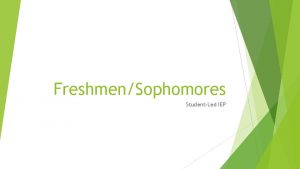Secondary Transition Planning Transition Instruction and IEP Requirements













































































- Slides: 77

Secondary Transition Planning Transition Instruction and IEP Requirements 2016

Vision and Mission of MDE Vision To create a world-class educational system that gives students the knowledge and skills to be successful in college and the workforce, and to flourish as parents and citizens Mission To provide leadership through the development of policy and accountability systems so that all students are prepared to compete in the global community Secondary Transition Planning Office of Special Education

State Board of Education Goals Strategic Plan 1. All Students Proficient and Showing Growth in All Assessed Areas 2. Every Student Graduates From High School and is Ready for College and Career 3. Every Child Has Access to a High-Quality Early Childhood Program 4. Every School Has Effective Teachers and Leaders 5. Every Community Effectively Using a World-Class Data System to Improve Student Outcomes 6. Every School and District is Rated “C” or Higher Secondary Transition Planning Office of Special Education

Why Plan for Transition? Are we limiting our students? Think College How have you addressed transition with your students? Why is transition planning important for students with disabilities? Secondary Transition Planning Office of Special Education 4

Current Postsecondary Outcomes for Students with Disabilities • Individuals with disabilities have the highest rate of unemployment of any group. More than twice that of people without disabilities. • More than two-thirds do not participate in workforce at all. • Students with disabilities are less likely to enroll in postsecondary education and are less likely to live independently than their nondisabled peers. Secondary Transition Planning Office of Special Education 5

Current Postsecondary Outcomes for Students with Disabilities According to 2010 America Community Survey (ACS): • Students with disabilities, including cognitive disabilities, who attain any level of postsecondary education have better employment outcomes than those without any postsecondary education. Secondary Transition Planning Office of Special Education 6

Do you see disabilities or abilities? Unrecognized potential and ability in school can result in wasted time and delayed or NO access to postsecondary dreams and goals. We must see impairments and needs but we must LOOK for and strengthen abilities! Everyone has a purpose, interests, and abilities! Secondary Transition Planning Office of Special Education 7

Definition of Transition A coordinated set of activities for a child with a disability that: • Is within a result-oriented process. • Is focused on improving academic and functional achievement. Secondary Transition Planning Office of Special Education 8

Definition of Transition • Facilitates child’s movement from school to post-school activities, including: – Postsecondary Education – Continuing and Adult Education – Vocational Training – Employment (Integrated or supported) – Adult Services – Independent Living – Community Participation Secondary Transition Planning Office of Special Education 9

Definition of Transition • Is based on the child’s needs, strengths, preferences, and interests. • Includes instruction, related services, community experiences, the development of employment and other post-school adult living objectives. • When appropriate, includes acquisition of daily living skills and functional vocational evaluation. (IDEA, 2004) Secondary Transition Planning Office of Special Education 10

Definition of Transition • IDEA 2004 states: Beginning not later than the first IEP to be in effect when the child turns 16, or younger if determined appropriate by the IEP Committee, and updated annually thereafter. • State Board Policy Chapter 74, Rule 74. 19: Beginning not later than the first IEP to be in effect when the child turns 14, or younger if determined appropriate by the IEP Committee, and updated annually thereafter. Secondary Transition Planning Office of Special Education 11

Transition At-a-Glance • • Postsecondary Outcomes College or University Job Corps Competitive Employment Supported/Integrated Employment Military Career/Technical School Apprenticeships/Internships Customized Employment Secondary Transition Planning Office of Special Education 12

What is Indicator 13? All states must submit Annual Performance Reports (APR) to the U. S. Department of Education through the Office of Special Education Programs around 20 IDEA related indicators. Indicator 13 relates to transition services for students with disabilities. Secondary Transition Planning Office of Special Education 13

What is Indicator 13? Indicator 13 measures: Percent of youth aged 16 (age 14 for the state of Mississippi) and above with an IEP that includes appropriate measurable postsecondary goals that are annually updated and based upon an age appropriate transition assessment, transition services, including courses of study, that will reasonably enable the student to meet those postsecondary goals, and annual IEP goals related to the student’s transition services needs. Secondary Transition Planning Office of Special Education 14

What is Indicator 13? Indicator 13 measures (cont. ): There also must be evidence that the student was invited to the IEP Team meeting where transition services are to be discussed and evidences that, if appropriate, a representative of any participating agency was invited to the IEP Team meeting with the prior consent of the parent or student who has reached the age of majority. (20 U. S. C. 1416(a)(3)(B)) Secondary Transition Planning Office of Special Education 15

Indicator 13 Checklist 1. Is (are) there a measurable, appropriate postsecondary goal or goals that covers: • Education or training? • Employment? • Independent living, as needed? 2. Are the postsecondary goals updated annually? Secondary Transition Planning Office of Special Education 16

Indicator 13 Checklist 3. Is there evidence that the postsecondary goals were based on age appropriate transition assessment(s)? Secondary Transition Planning Office of Special Education 17

Indicator 13 Checklist 4. Are there transition services in the IEP that will reasonably enable student to meet his or her postsecondary goals? Secondary Transition Planning Office of Special Education 18

Indicator 13 Checklist 5. Do the transition services include courses of study that will reasonably enable student to meet his or her postsecondary. Secondary Transition Planning Office of Special Education 19

Indicator 13 Checklist 6. Is (are) there annual IEP goal(s) related to the student’s transition services needs? Secondary Transition Planning Office of Special Education 20

Indicator 13 Checklist 6. Is (are) there annual IEP goal(s) related to the student’s transition services needs? (continued) • The number listed for related IEP goal(s) must match annual goal(s) aligned to the postsecondary goal. The IEP goals should address areas of need that may impact the student’s ability to pursue his or her postsecondary goals. These areas of need must be identified in the PLAAFP. Therefore, when checking compliance to #6 the following areas on the IEP will be examined: PLAAFP, related IEP goals listed with postsecondary goals, and the numbers of related IEP goals listed with postsecondary goals. All 3 areas should align. Secondary Transition Planning Office of Special Education 21

Indicator 13 Checklist 7. Is there evidence that the student was invited to the IEP Committee meeting where transition services were discussed? Secondary Transition Planning Office of Special Education 22

Indicator 13 Checklist 8. If appropriate, is there evidence that a representative of any participating agency was invited to the IEP Committee meeting with prior consent of the parent or student who has reached the age of majority? Secondary Transition Planning Office of Special Education 23

A Transition-Rich IEP Transition Assessment and Present Levels of Academic Achievement and Functional Performance Designated Responsibility Measurable Postsecondary Goals Annual IEP Goals Annual Activities and Services, Including Course of Study Secondary Transition Planning Office of Special Education 24

Student Involvement Evidence of student invitation to IEP Committee meeting is documented in the IEP or cumulative folder (e. g. a letter inviting the student to the meeting). Dated prior to IEP Meeting. Secondary Transition Planning Office of Special Education 25

Age-Appropriate Transition Assessments • Postsecondary goals must be based on ageappropriate assessments. • Transition assessment is the ongoing process of collecting data on a student’s needs, preferences, and interests as they relate to the demands of current and future employment, educational, living, personal and social environments. • Forms the basis for defining goals and services to be included in IEP. Secondary Transition Planning Office of Special Education 26

Age-Appropriate Transition Assessments • At least one age-appropriate transition assessment for each postsecondary goal. • Assessment may be formal, informal, or combination of both. • Must provide information on student’s needs, strengths, preferences, and interests. Secondary Transition Planning Office of Special Education 27

Age-Appropriate Transition Assessments Examples of Formal Assessments: • Adaptive Behavior/Daily – e. g. Vineland Adaptive Behavior Scales • Aptitude Tests – e. g. TABE, Armed Services Vocational Aptitude Battery, OASIS-III Aptitude Survey • Achievement Tests – e. g. Woodcock Johnson III, Kaufman Test of Individual Achievement • Interest Inventories – e. g. i. CAP Secondary Transition Planning Office of Special Education 28

Age-Appropriate Transition Assessments Examples of Informal Assessments: • • Parent Interviews/Surveys Student Interviews/Surveys Observation – Classroom, community, work Checklists Work Samples Informal Interest Inventories – Casey Life Skills Curriculum-Based Assessments – e. g. Brigance Life Skills Inventory, Brigance Transition Skills Inventory, Unique Learning Systems Transition, CEC Life. Centered Education Secondary Transition Planning Office of Special Education 29

Resources for Assessments Websites with formal and informal assessments: • • • National Center on Secondary Education and Transition http: //www. ncset. org/topics/career/default. asp? topic=1 Zarrow Center at University of Oklahoma http: //www. ou. edu/content/education/centers-andpartnerships/zarrow/transition-assessment---severedisabilities. html South Bend Community School Transition Assessments and Activities http: //sped. sbcsc. k 12. in. us/ppm/transitionplanning/trans itionassessments. html Secondary Transition Planning Office of Special Education 30

Resources for Assessments • ESTR Publications Enderle-Severson Transition Rating Scale. $20 per 10 reports. http: //www. estr. net/index. cfm • Casey Life Skills http: //lifeskills. casey. org/ • Transition Assessment Matrix http: //www. iidc. indiana. edu/styles/iidc/defiles/CCLC/tr ansition_matrix/Transition_Matrix. html • Pictorial Career Interest http: //achieve. lausd. net/Page/6088 Secondary Transition Planning Office of Special Education 31

Resources for Assessments • Career Cluster Videos http: //www. careeronestop. org/Videos/Careerand. Clust er. Videos/career-and-cluster-videos. aspx • Transition Assessment for Autism http: //achieve. lausd. net/cms/lib 08/CA 01000043/Centr icity/Domain/220/Transition%20 and%20 Vocational%2 0 Skills%20 assessment. pdf • Quick. Book of Transition Assessments http: //www. ocali. org/up_doc/Quickbook_of_Transitio n_Assessment. pdf Secondary Transition Planning Office of Special Education 32

Resources for Assessments Task Analysis: written list of the discrete steps required to complete a task, such as doing laundry, brushing teeth, mopping a floor, setting a table, maintaining a work setting, etc. Website with samples: • http: //www. ttacnews. vcu. edu/2012/08/task-analysisteaching-multistep-skills-made-easy/ Secondary Transition Planning Office of Special Education 33

Resources for Assessments • Employment Support Indicators http: //www. ouhsc. edu/thecenter/products/ESI. asp • Community Based Skills Assessment https: //www. autismspeaks. org/sites/default/files/docu ments/familyservices/community_assessment_tool_kit. pdf Secondary Transition Planning Office of Special Education 34

Age-Appropriate Transition Self. Determination Assessments Self-Determination includes: • • Self-awareness Self-efficacy Self-advocacy Decision-making Self-management Self-evaluation Self-Adjustment Problem-solving Secondary Transition Planning Office of Special Education 35

Self-Determination Assessments AIR Self-Determination Assessment http: //www. ou. edu/content/education/centersand-partnerships/zarrow/self-determinationassessment-tools. html • Focuses on individual’s capacity and opportunity to use knowledge and abilities. • Cost: Free Secondary Transition Planning Office of Special Education 36

Teaching Self-Determination • Provide opportunities for students to make choices, starting in elementary school. • Promote active involvement in educational training (student-led IEP) and decision. • Promote career awareness. • Choose a vocational goal and complete evaluation. Ask students: • What will it take to reach your goal? • What steps must you take to achieve your goals? • Know what you want and how to get there! Secondary Transition Planning Office of Special Education 37

Self-Determination Assessments I’m Determined http: //www. imdetermined. org/educators/videos/ (video) • Self-determination instructional resources, videos, assessments • Cost: Free Secondary Transition Planning Office of Special Education 38

Age-Appropriate Transition Assessments Assessment Type: i. Cap, Student Survey, Parent Survey Responsible Agency/Person: Teacher, School, Voc Rehab Date Conducted: Assessments must be conducted before development of postsecondary goals. Report Attached: Report summarizing results of assessment. Mark Y if attached to IEP. Mark N if located in student IEP folder or transition folder. Secondary Transition Planning Office of Special Education 39

Age-Appropriate Transition Assessments Secondary Transition Planning Office of Special Education 40

Present Levels of Academic Achievement and Functional Performance The IEP Committee must identify where the student is functioning (strengths and needs) in relationship to what he/she plans on doing after exiting high school. Must include the results of any assessments that were used to determine strengths, needs, interests, and preferences. Postsecondary goals must be aligned to interests identified in PLAAFP. Annual IEP goals related to postsecondary goals must be based on needs identified in the PLAAFP that may impact the student’s ability to achieve his or her postsecondary goals. Secondary Transition Planning Office of Special Education 41

Present Levels of Academic Achievement and Functional Performance (Gen Ed) Secondary Transition Planning Office of Special Education 42

Present Levels of Academic Achievement and Functional Performance (Gen Ed) Secondary Transition Planning Office of Special Education 43

Present Levels of Academic Achievement and Functional Performance Secondary Transition Planning Office of Special Education 44

Postsecondary Goals Postsecondary goals must be measurable. Must be based on age-appropriate assessment. Goals identify an outcome, not a process. Must be updated annually. Each goal must have related IEP annual goal(s)and transition services. • At least one goal for each adult outcome area: Ø Education or Training (required) Ø Employment (required) Ø Independent Living (when appropriate) • • • Secondary Transition Planning Office of Special Education 45

Postsecondary Goals: Questions to Consider • Where and how is the student going to continue to learn and/or develop skills after graduation? Education/Training • Where is the student going to work or engage in productive activities after graduation? Employment • Where is the student going to live and how is he or she going to access adult services, participate in the community and have fun after graduation? Independent Living Secondary Transition Planning Office of Special Education 46

Postsecondary Goals: Formula for Writing Use the following formula when writing postsecondary goals: will (After high school) (The (After graduation) Student) (Upon completion of High school) (Behavior) (Where and How) Only use “graduation” if student is receiving a general education diploma. Secondary Transition Planning Office of Special Education 47

Education/Training Postsecondary Goals (Gen Ed) Use the following formula when writing postsecondary goals: After graduation, Sue (After high school) (The (After graduation) Student) (Upon completion of High school) enroll in LPN program at Jones Community College with will support from disability services. (Behavior) Secondary Transition Planning Office of Special Education (Where and How) 48

Education/Training Postsecondary Goals Must have at least one goal for Education or Training. Examples of postsecondary education or training: Community College, University, Vocational Training Programs, GED, Apprenticeship, Job Corps, On-the-Job Training, Workforce Investment Act, Independent Living Skills Training (ARC, Supported Employment, Job Coach). Secondary Transition Planning Office of Special Education 49

Employment Postsecondary Goals Must have at least one goal for Employment. Examples of postsecondary employment: Volunteer Work, Part-Time Employment, Full-Time Employment, Military, Competitive Employment, Supported/Integrated Employment, Customized Employment. Secondary Transition Planning Office of Special Education 50

Independent Living Postsecondary Goals Must have at least one goal for Independent Living, if appropriate. Examples of postsecondary goals for Independent Living: Use public transportation independently or with support, live independently with a roommate, supported living, participate in community-based activities, assist with personal care, budget and pay bills. Secondary Transition Planning Office of Special Education 51

Postsecondary Goals for Student in General Education Secondary Transition Planning Office of Special Education 52

Annual IEP Goals • For each postsecondary goal, there must be an annual goal or goals included in the IEP that will help the student make progress towards the stated postsecondary goal(s). • Annual IEP Goals must be SMART: Ø Specific Ø Measurable Ø Action Oriented Ø Relevant and Realistic Ø Time-Limited Secondary Transition Planning Office of Special Education 53

Components of Measurable Annual IEP Goals Measurable annual goals must have the following components: will (Condition) (Student) (Behavior) (Criteria) (Time Frame) Given multi-step tasks with at least 4 steps while working at job sites in the community, Mary will complete all tasks independently with 80% accuracy in 4 out of 5 trials by the end of the school year. Secondary Transition Planning Office of Special Education 54

PLAAFP Summary Statements and Annual Goals (Gen Ed) Secondary Transition Planning Office of Special Education 55

PLAAFP Summary Statements and Annual Goals (Gen Ed) Secondary Transition Planning Office of Special Education 56

PLAAFP Summary Statements and Annual Goals (Gen Ed) Secondary Transition Planning Office of Special Education 57

Annual IEP Goals “An effective IEP is a living document not a sheaf of senseless gibberish that is filed away as soon as the IEP meeting is over. Meaningful goals are written in plain English, and describe real-life activities that a child can master (instead of isolated behaviors or skills). ” -Kathy Snow, Disability is Natural www. disabilityisnatural. com Secondary Transition Planning Office of Special Education 58

Transition Services • • • Transition services are the coordinated activities designed to help a student reach their postsecondary goals. Activities should focus on academic and functional achievement necessary to facilitate successful transition from school to post-school life. Must be based on student’s individual needs, strengths, preferences, and interests. Type and amount of transition services will differ from student to student. At least one transition service must be identified for each measurable postsecondary goal. List of Coordinated Set of Activities and Strategies https: //www. seattleu. edu/uploaded. Files/CCTS/EXAMPLES% 20 OF%20 TRANSITION%20 SERVICES. pdf Secondary Transition Planning Office of Special Education 59

Transition Services Secondary Transition Planning Office of Special Education 60

Transition Services • • • Activities must be aligned to postsecondary goals and identified areas of need in the PLAAFP. List any outside agency that will provide services. See pages 58 – 60 of IEP Guidance Document http: //www. mde. k 12. ms. us/docs/sped-informationpage/iep-guidance-doc-2014 -07 -02. pdf? sfvrsn=2 Secondary Transition Planning Office of Special Education 61

Transition Services: Instruction Activities/strategies related to formal or informal imparting of knowledge and skills. Possible examples: • Access tutoring services at school. • Enroll in self-advocacy training. • Complete instruction related to computer skills/word processing. • Complete learning styles inventory. • Identify support services at community college. • Enroll in a career technical program. • Take GED pre-test. • Take CPR/First Aid course. • Enroll in ACT prep course. • Take Driver’s Education. Secondary Transition Planning Office of Special Education 62

Transition Services: Related Services Specifies related services needed for successful transition to post-school life and what student will need to access those services. Possible examples: • Visit community health agencies in the area. • Apply for Supplemental Security Income (SSI). • Explore transportation options. • Obtain orientation and mobility services. • Use augmentative communication device in a work setting. • Complete assistive technology evaluation. • Identify potential post-school providers of recreational therapy or occupational therapy and funding sources. • Apply for home-based waiver. Secondary Transition Planning Office of Special Education 63

Transition Services: Community Experiences Specifies activities or experiences generally provided off school campus and to prepare student for participation in community life. Possible examples: • Tour postsecondary training programs. • Develop skills to grocery shop independently. • Learn how to access relevant community resources (library, postal services, restaurant, heath care facilities, bank) • Obtain state identification. • Identify community civic organizations to join. • Complete at least three job shadowing experiences throughout the school year. • Explore new leisure and recreation activities. • Practice banking and budgeting skills. Secondary Transition Planning Office of Special Education 64

Transition Services: Employment and Functional Vocational Evaluation Specifies activities focused on development of work-related behaviors, career exploration, skills training and any assessments needed to provide information about career interests, aptitudes, and skills. Possible examples: • Complete career interest inventory. • Meet with career counselor. • Learn about employment rights for adults with disabilities (ADA and Section 504). • Take the ASVAB • Attend career fair at local college. • Meet with counselor from Vocational Rehabilitation. • Join career-related school club such as Allied Health or Future Business Leaders of America. • Complete a resume. Secondary Transition Planning Office of Special Education 65

Transition Services: Daily Living Skills and Post-School Living Objectives Specifies activities focused on development of skills adults need in everyday life. Possible examples: • Register to vote. • Obtain a driver’s license. • Identify information needed to file taxes. • Take childcare classes. • Enroll in culinary arts class. • Read and understand direction for medications. • Develop emergency procedures for use at home. • Schedule and keep medical appointments. • Identify appropriate clothing for work and leisure. • Develop a monthly budget. • Identify services provided by a bank. Secondary Transition Planning Office of Special Education 66

Transition Services Examples Secondary Transition Planning Office of Special Education 67

Transition Services Examples Secondary Transition Planning Office of Special Education 68

Exit Options Standard High School Diploma: Only option leading to graduation. Three pathways: Traditional, District, and Career Pathways. General Educational Development (GED): High school equivalency credential. Mississippi Occupational Diploma (MOD): Not a standard high school diploma or equivalency credential for most postsecondary education and training programs or Federal financial aid programs. Focus is employability skills. Certificate: Certificate of completion is acknowledgement of child’s participation in and completion of his/her IEP. Secondary Transition Planning Office of Special Education 69

Course of Study When selecting the course of study for a student, the IEP Committee must consider the specific requirements for each exit option and specific entry requirements for postsecondary college and/or career selected. Secondary Transition Planning Office of Special Education 70

Course of Study Secondary Transition Planning Office of Special Education 71

Coordination of Services Agencies who are currently involved with child or family or are likely to become involved in providing support or services once the child exits high school. Written parental consent must be obtained prior to inviting an agency representative to an IEP meeting or before sharing any information. Secondary Transition Planning Office of Special Education 72

Coordination of Services Examples of Mississippi agencies (see page 64 -65 of IEP Guidance Document): • Vocational Rehabilitation Agency (VR) • Mental Health Agencies • Independent Living Centers • Social Security Administration (SSA) • Department of Health • Mississippi Council on Developmental Disabilities Secondary Transition Planning Office of Special Education 73

Summary of Performance (So. P) When students exit from special education, public agencies are required to provide them with a So. P to facilitate their transition to desired postsecondary settings. Summary of Performance: Created for a student exiting with a standard high school diploma, GED or due to exceeding the age of eligibility. Summary of academic achievement and performance along with recommendations concerning how to assist the student in meeting postsecondary goals. MDE So. P Secondary Transition Planning Office of Special Education 74

Additional Information For additional examples and resources, please review the Volume V: Secondary Transition Procedures Manual http: //www. mdek 12. org/OSE/PP Secondary Transition Planning Office of Special Education 75

Resources National Secondary Transition Technical Assistance Center. Secondary Transition Model http: //www. mde. k 12. ms. us/specialeducation/secondary-transition-services Think College http: //www. thinkcollege. net/ MDE Secondary Transition Volume V Procedures http: //www. mde. k 12. ms. us/OSE/PP Secondary Transition Planning Office of Special Education 76

Contact Information Candice Kelly Transition Instructional Support Specialist Office of Special Education ckelly@mdek 12. org Devin Boone Professional Development Coordinator Office of Special Education Devin. Boone@mdek 12. org Stacey Todd Professional Development Coordinator Office of Special Education Stacey. todd@mdek 12. org Secondary Transition Planning Office of Special Education 77
 Differentiated instruction vs individualized instruction
Differentiated instruction vs individualized instruction § 367 abgb
§ 367 abgb Planning and conducting instruction in the classroom
Planning and conducting instruction in the classroom Rafsanjani soga secondary school location
Rafsanjani soga secondary school location Carol kosnitsky
Carol kosnitsky Iep development and implementation
Iep development and implementation Iep meeting do's and don'ts
Iep meeting do's and don'ts Catechetical instruction lesson planning
Catechetical instruction lesson planning Indiana secondary transition resource center
Indiana secondary transition resource center Wedding planning system
Wedding planning system Mrp is generally practiced on items with dependent demand.
Mrp is generally practiced on items with dependent demand. Material requirements planning
Material requirements planning Mrp drp erp
Mrp drp erp Lot sizing techniques in mrp
Lot sizing techniques in mrp Material requirements planning concepts
Material requirements planning concepts Gross material requirements plan
Gross material requirements plan Enterprise requirements planning
Enterprise requirements planning Capacity requirements planning
Capacity requirements planning Capacity requirements planning
Capacity requirements planning Capacity requirements planning
Capacity requirements planning Mrp system
Mrp system Iep meeting quotes
Iep meeting quotes Sspt intervention plan
Sspt intervention plan Contoh iep anak berkebutuhan khusus
Contoh iep anak berkebutuhan khusus Louisiana special education reporting system
Louisiana special education reporting system 6 pillars of idea
6 pillars of idea Iep meeting agenda
Iep meeting agenda Plaafp examples
Plaafp examples Iep utm edu
Iep utm edu Onlineiep
Onlineiep Plep a vs plep b
Plep a vs plep b Md online iep
Md online iep Iep development
Iep development Iep meeting agenda
Iep meeting agenda Listening comprehension iep goals
Listening comprehension iep goals Characteristics of gifted students
Characteristics of gifted students Iep goal for citing textual evidence
Iep goal for citing textual evidence Oklahoma iep
Oklahoma iep Script for iep meeting
Script for iep meeting Iep components special education
Iep components special education Maryland online iep
Maryland online iep Iep justification statement examples
Iep justification statement examples Web iep
Web iep Virgen
Virgen Wvde iep
Wvde iep Gifted iep goals
Gifted iep goals Iep
Iep Md online iep
Md online iep Sesis
Sesis Iep
Iep Quality services iep
Quality services iep Iep trailer chassis only
Iep trailer chassis only Iep process
Iep process Present levels of performance iep examples
Present levels of performance iep examples Iep
Iep Sesis
Sesis Realtime iep
Realtime iep Sb277 iep exemption
Sb277 iep exemption Individualized education plan
Individualized education plan Ccr iep
Ccr iep Aec tutoring uri
Aec tutoring uri Iep goal
Iep goal N planning
N planning Long medium and short term planning in primary schools
Long medium and short term planning in primary schools What is language planning
What is language planning Police operational planning
Police operational planning Formal and informal assessments
Formal and informal assessments Strategic planning vs tactical planning
Strategic planning vs tactical planning Goal achievement matrix
Goal achievement matrix Scenario planning workforce planning
Scenario planning workforce planning Aggregate planning is capacity planning for
Aggregate planning is capacity planning for List the strategic objectives of aggregate planning
List the strategic objectives of aggregate planning Examples of aggregate planning
Examples of aggregate planning Multiple intelligences and differentiated instruction
Multiple intelligences and differentiated instruction How to write work instructions
How to write work instructions Pros and cons of gagne's nine events of instruction
Pros and cons of gagne's nine events of instruction Anita archer explicit instruction
Anita archer explicit instruction Interlocking model of curriculum
Interlocking model of curriculum


